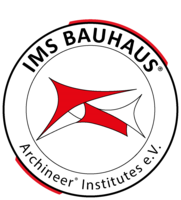Design, planning and structural calculation:
Prof. Dr. Robert Off, Dipl.-Ing. Wolfgang Warisch, Hans Jürgen Gartner
Production:
Stephan Löffert, Sabrina Motaleb Off
Installation:
Members IMS e.V.

Birth of the project
Within, the new design and the construction of the extension of a school in Bobingen by the architect Dr.Robert Off, he suggested to the township of Bobingen to use a membrane construction in the concourse hall for aesthetic and acoustic reasons. This innovative component had to be designed and constructed as a new composite construction element

Fundamental thoughts of the architect
The school hall had a double-storey volume of space enclosed by a fully glazed curtain wall on the outside and solid floors, therefore the acoustic situation was very poor. To improve the poor situation it would have been necessary to fix acoustic elements like an acoustic gypsum board ceiling or similar. All these kinds of solutions would have ruined the impression of the hall, would have soon gotten dirty, dusty and would have eventually looked ugly . It was decided to install a floating acoustic barrier, consisting of double layer membrane with acoustic sandwich in the middle. The appearance had to be aesthetically pleasing.

Membrane - Fabrics
The choice of the right membrane material to achieve an “art-acoustic„ construction turned out to be more difficult than it seemed initially. PVC coated material or other smooth plastic–like coating is inadequate for a school, as it would create an unpleasant feeling with the parents concerning the health of their children. PTFE was considered as an alternative, but required a much higher pre-stress for developing, the intended shape of the membrane with strong curvature, thus subjecting the concrete support structures to high anchoring forces for which they were not built. Ordinary curtain material would not be able to take the minimum pres-stress that would be required to develop the shape chosen.
The solution adopted was to use a non-coated polyester material with fire retardency class B1. This material was manufactured, supplied and sponsored by KoSa. Colour testings on canvas-like polyester material gave suffícient fixation, hence considered suitable for the art-acoustic.

Jointing and seam
The uncoated material could not be joined by high frequency welding or glueing, therefore we had to resort the traditional sewing method.
Furthermore different needles and threads had to be tested. More than 50 laboratory tests were executed on tear strength, seam strength and fabrics edge reinforcement done by KoSa in their own labs.

It was necessary to develop a kind of reinforcement for the jointing area of the fabrics. The new devloped and tested treatment of the jointing area of the fabrics causes low costs and is simple and easy to handle.
Additional difficulties had to be overcome as the membrane was to be build in two independent membrane layers but acting like one single sandwich.
Membrane production
1) Originally sized paper plots of each pattern
2) Marking the fabrics
3) Patterning of the fabrics using a heat-cutter
After reinforcing the jointing area of the fabric patterns the prepared seam areas were fixed with a double side adhesive tape. Using the suitable pins (due to the testing), the patterns were sewed with a 3 time seam as well as all the pockets and belt fixtures.
Artistic design and realization
Hans Jürgen Gartner is a well known artist, borne in Vienna, Austria, he is decorated with numerous art prices. His work area is art at construction sculptures, objects, paintings and colour and artistic design concepts.
The lower sides of the membrane fabric were first coated white.The membranes are then painted with different yellow colours floating into each other. For the lower sides the artist used a brush technique using a broom. For this technique lot of experience, know how and artistic knowledge is required. The upper sides were painted in powerful yellow. The technique used was a Rolling Technique.
Membrane erection
After the artistic treatment of the membrane fabrics were finished, the acoustic foam was fixed on the lower membrane. All four membranes, steel parts and cables were then delivered to the site. On site the the lower and upper membranes were fixed together by attaching the adjustable edge cables to the common steel parts, which were survey and fixed on the anchor points. Fixation of the anchor steels plates to the columns by chemical dowels. After a two days period (maturing of the dowels) the actual installation of the membranes could proceed. The fixation cables were attached to the anchor plates and the membranes were finally pre-stressed using the turnbuckles in the fixation cables.




